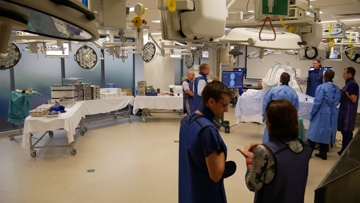
SVC Podcast – Show Notes – Show 178-2
In this edition of the SVC Podcast, Contributing Editor Bennett Liles resumes his talk with Iain Brew, the Clinical AV and IT Coordinator at Macquarie University in Sydney, Australia about the recent technical overhaul of their advanced Surgical Skills Lab. Iain comments on the audio system featuring the Behringer X32 mixer, the challenge in making the existing components talk to the new gear and the big job of implementing sustainability throughout the project.
TO GO TO PART 1 OF THIS PODCAST
Links of interest:
- The Gefen EXT-MFP Scalers that translate between the existing gear and the new technology items
- Video tour of the new Surgical Skills Lab by Iain Brew
- iRidium Mobile – Software for AV control
Download Podcast Here:
https://s3.amazonaws.com/nb-svc/public/public/178-2_Macquarie_Surgical_L…
Transcript-
This is the SVC Podcast from Sound & Video Contractor Magazine with Iain Brew of Macquarie University. Show notes and equipment links for the podcast are on the web site of Sound & Video Contractor Magazine at svconline.com.
It was a big enough job doing a total upgrade to IP video distribution and getting lots of existing AV equipment to work with the new gear but Clinical AV and IT Coordinator Iain Brew got the whole thing done in-house using faculty members. We’re going all the way to Sydney, Australia where he’s taking us inside the new Surgical Skills Lab at Macquarie University right now on the SVC Podcast.
Iain, great to have you back with us for Part 2 of the SVC Podcast from Macquarie University in Sydney, Australia. Clinical AV and IT Coordinator where your most recent big AV project was the total revamp of the Surgical Skills Lab there. From the pictures, that looks like a lot of equipment and swing arms to thread cable through. You changed over to all IP video distribution. Was that the primary technical upgrade you did?
So I think our highest priority was to improve the control of what we had. However, as we went deeper into the project we realized that we really needed to start thinking about the quality of our audio and video as well, so we did it as a coherent project. So in order to do so we needed a new matrix because we have so many inputs and outputs in the space that was going to get very expensive very fast. And I also wanted something that was going to be scalable for other upgrades we might be doing in our building so that we can link everything together with a common system, so video over IP was the logical step for us. So I looked at a few different products, and as I mentioned in Part 1 designed a video wall for our new library in 2010 and we used video over IP products back then when they were quite new and they were not without their issues. So this is sort of the second time I’ve delved into video over IP and I looked at quite a few different products in the market. And the thing that stood out for me for the Gefen solution was their matrix controller. So it’s a piece of hardware that sits on the network that can receive simple routing commands and then that figures out all the complicated multicasting and network configuration for you. So it’s very, very easy to program and get started compared to other products where you have to actually talk to the switch itself by logging into its console and it’s reaching V-LAN, so all sorts of complicated things. So the Gefen product seemed to be the logical solution, and the other thing I like about it is it’s highly scalable. I think from their web site you can have up to 65,000 devices. I hope we never reach that number. That would be quite a mess of work to look after. But the other great thing is that they’ve just released their new ultra-high definition products, but it’s backwards compatible with the high definition products that we’ve bought. So we don’t have to, in a year’s time when we do something in another part of the building, we don’t have to rip everything out and start again. They will talk to each other. So I think that’s fantastic that our investment is protected and future-proofed. [Timestamp: 3:11]
I know that one thing that doesn’t show in the pictures but was central to this project was sustainability. You didn’t just rip out all of the old stuff and throw it in the trash. What was your plan to implement sustainability on this project?
So sustainability is something that’s very important to me personally and also at the university I actually worked for eight years in the Macquarie University Sustainability Department led by Director Leanne Denby. So sustainability is something I take a holistic approach to when I’m working and it’s something that is ingrained in everything I do with the university. So people might think with technology and AV how can it be sustainable? Well, I sort of used the three R principal. So that was reduce, reuse and recycle. So for example, in the reduce category I chose a component system. So for example, I only have to buy the boxes that I need today to make the system work. I don’t have to buy a 32 x 32 or 64 x 64 matrix with half the capabilities never used, which has happened in the past. Now if I want to add capability I just add a second network switch, which is quite expensive, but I’ve got an additional 48 interface ports which is fantastic. And also by switching to an IP-based system, I have a lot less cabling and a lot less burden. In terms of reusing, we reused a lot of the stuff around because there’s a lot of stuff in our lab that’s still working perfectly fine; all the speakers, amplifiers, the existing projector, the existing medical displays amongst a few other bits and pieces. There’s no need to replace them so we were able to integrate that into our new equipment and new control system. And in terms of recycling, like I mentioned we pulled out two cubic meters or cable through the roof. That will all get sent away and all the metal stripped out and recycled. All the packaging we used was recycled. Dr. Janos Tomka’s son, Adam, came in actually during the school holidays and he was fantastic pulling boxes apart and separating things for us. So we had help from all sorts of sectors of our community. And Gefen was quite good on that. Normally when you buy a technical device these days they’re built for an international market so you end up with a box of every international plug under the sun. Of course we only need the Australian plug if we’re ever going to use the power supply. So for all the other plugs, Gefen actually takes those back and can reuse them elsewhere in the world. So it was fantastic that considering the amount of products we bought we saved a lot of stuff going to landfill. So that’s sort of how we lightly tried to achieve some sustainability principals with our upgrade project. [Timestamp: 5:39]
And for all of the equipment you’ve got in the lab it looks remarkably uncluttered. Where is all of the rack equipment located?
It’s disappointing sometimes. I bring people in and they’re like, “We can’t see anything. It’s all hidden.” It’s all hidden behind the surgical monitors up in the plenum space. But the heart of the system is located in a storeroom next door to the lab, so that’s where the existing AV system was so there was already cable trays and cable paths back to there so it made sense to bring everything back to that space. But it also keeps it out of sight and out of mind and also secure. So not anyone can go into that room and tamper with the system or change a setting, for example. So it keeps it nice and secure which is quite an important thing in our space to ensure the system is secure and safe. [Timestamp: 6:20]
One of the items of equipment that got my attention was the Behringer digital sound mixer. I went to their site and it looks like a mixer that you would more likely find in a performance venue or recording studio. How do you use the Behringer X32?
Well, the short answer is we use it in an unorthodox fashion. I’ve used the Behringer X32 console in another project for the university. So I look after all the live streaming of our graduation ceremonies and we use an X32 to manage all the sound for that. And I found it to be very powerful and very versatile, but also very cost-effective. So it offers 32 channels in, 16 channels out, heaps of processing power both on inputs bus connection points and outputs. So I thought when we built this lab I wonder if I could use the X32? So when I went to the Integrate Expo, which is held here in Australia – a big sort of tech show we have every year – I went up to the Behringer guys and I said here’s what I want to do. They said you’re not the first person to ask this question. So that gave me a bit of confidence that hang on, I could probably pull this off. So I did a lot of testing with the X32 console that we own and I discovered somebody’s published online an OSC library so basically any control you can have on the X32 can actually be controlled via UDP commands over a network. So I thought well, I don’t need to do anything too complicated; some muting, routing changes and volume control. So I was able to replicate all those functionalities from the iRidium control software. So we went ahead with the X32 and it’s been absolutely fantastic for us, especially because there’s a visual screen on the front so I can see what’s going on. And when I was programming the system I could actually get my big console, digitally link it back to the rack so I could actually sit in the lab itself and fine-tune the audio and sweeten the sound while actually sitting there. I didn’t have to hide in a storeroom with a laptop and run backwards and forwards with test material. So that made life very easy, but also an incredibly cost-effective piece of equipment. [Timestamp: 8:17]
The increased detail you now have on the monitors would seem to come in very handy when you’ve got arthroscopes and microscopes connected among the video sources.
For our medical displays we have Stryker Vision Elect 26” medical displays which were the existing products installed when the lab was built. We have all sorts of medical equipment and sometimes medical equipment can have quite funky EDIDs we discovered that could throw things out of sync or give you weird resolutions. So the Gefen products have handled that quite well. We had a few endoscope products that when we connected DVI to HDMI into the Gefen boxes it just wasn’t playing nice, so we used SDI to HDMI adapters. So we’ve put 10 of those throughout the lab so if you’re using a piece of medical equipment we recommend that people connect via SDI, so it’s standards-based 1080p signal. That feeds through the converter into the HDMI system and beautiful pictures wherever we need them. We have endoscopes, we have arthroscopes, C-arm x-ray machines. Of course the medical community that come to use our lab will bring all sorts of interesting things like medical robots. We’re seeing a lot more 3D things come in, ultrasound machines. And there’s more and more increasing demand now for medical equipment to have video outputs and high-quality video outputs so that it’s easy to share and record information from those devices. [Timestamp: 9:41]
That’s a lot of stuff to get connected right AND to get all of the existing and in some cases older gear to talk to the new hardware. I’m sure you knew that when you planned all of it but when you actually get the equipment in your hands it’s got to be a pretty formidable task.
That’s right. We’ve had all sorts of equipment come through and luckily, with the use of the SDI to HDMI adapters – and we’ve also bought some scales, because quite a lot of medical equipment, which was a surprise to me, still only has composite view or S-video connections. So a lot of medical equipment still hasn’t quite made the jump to high-definition yet. So we have to be ready for any piece of equipment to roll in the door and plug in. And so far we’ve not had any issue with being able to plug every piece of equipment in and get a good picture out of it. [Timestamp: 10:22]
And once you did get the whole system up and running how long did it take to get everybody trained and ready to use it?
Training wasn’t too hard. As you touched on before quite rightly, because we’ve all been involved in the upgrade process we all know the system quite well. And the same thing with the control system. When we first started I printed out a picture of an iPad with a white screen. We would actually draw everything out together. So I would say here’s some ideas and we’d scribble and draw and only when we were happy did everything go off into the computer and we’d actually start building it. So people were already familiar with the control system because it was the lab users themselves who directed how they wanted it to look and feel. So in terms of training I have done some basic training with our lab users and we sort of look at it as there’s two levels. So the system when you first turn it on gives you a bunch of presets for our most common use of the lab. So all they have to do is push start, wait for the system to turn on, and then push a preset. So within one to two clicks they can actually get the lab set up and then they can just forget about it and go about their teaching or research. However, you can go deeper. We’ve got pages where you can route any video source and view your destination, same with audio, streaming, recording and also room control – so blinds, projector screens, blanking of screens and also control over Apple TV that we use for wireless presentation. So for all those other things when I’m not around, I made a little booklet that staff can access to quickly get a rundown on it. It’s sort of s cheat sheet almost on “I want to do this thing, how do I do it?” And they can just find it on the cheat sheet and so far so good. Everyone’s been very happy with it. [Timestamp: 11:52]
Super project and the Surgical Skills Lab is a truly a remarkable facility. The total upgrade project with Clinical AV and IT Coordinator Iain Brew of Macquarie University in Sydney, Australia and all of it done in-house. Thanks for telling us about it Iain.
My pleasure. Thanks for having me on your podcast.
Thanks for getting with us on the SVC Podcast with Iain Brew. Show notes and equipment links are on the website of Sound & Video Contractor Magazine at svconline.com. Be back with us next week when we go to Tennessee with Lowrance Sound Company on the SVC Podcast. We’ll see you then.










